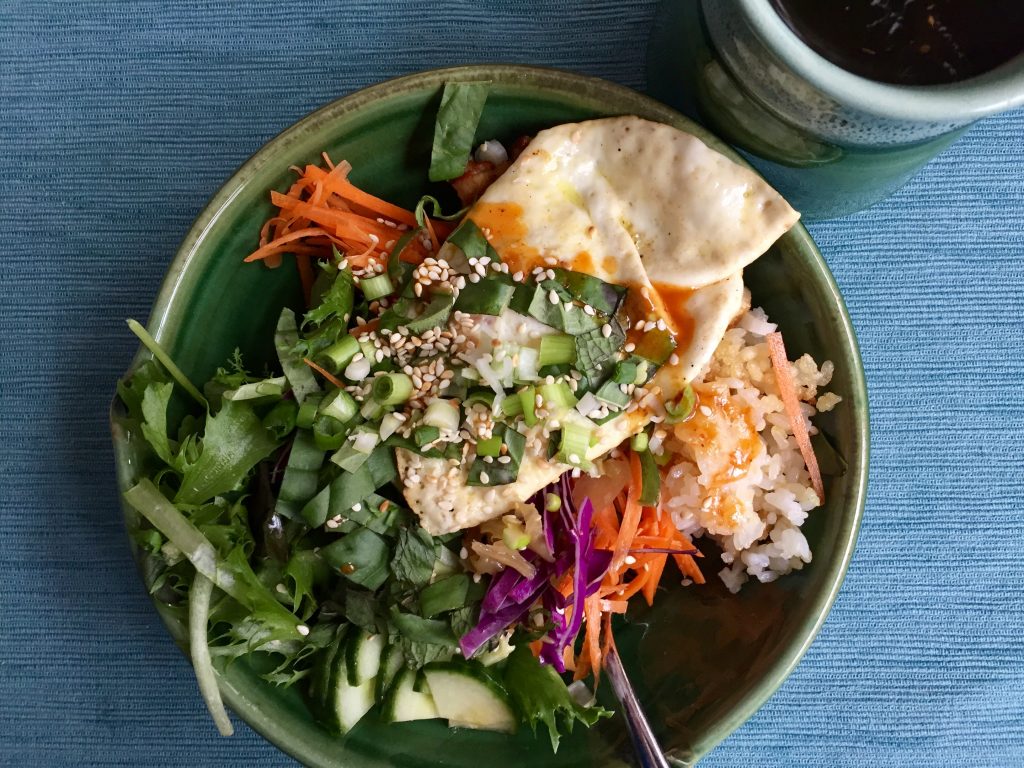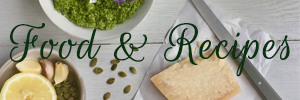Here, it’s just me and my husband (who, thankfully, is a good cook in his own right and, more often, a willing sous chef, ready to chop and grate on demand), and I frequently fly solo when he works on the road. Fortunately I had about a decade of cooking for one under my belt before we met. How do you prepare healthy food on a small scale without getting overwhelmed by the prep or getting endlessly bored of the same leftovers all week? Whether you’re a new home cook or an experienced one looking for small-scale inspiration, here are some of my tips of the trade…
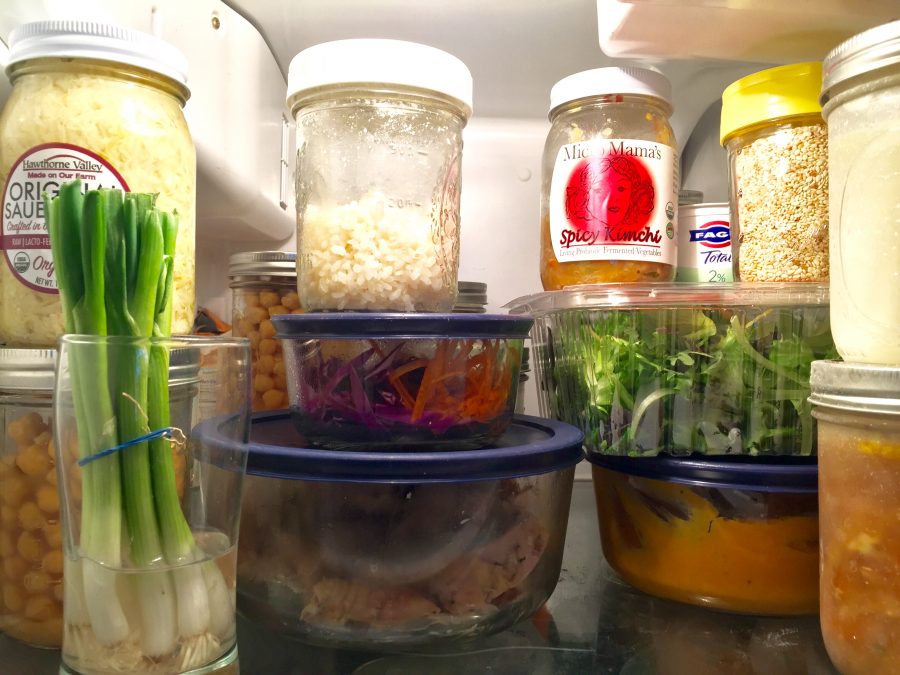
Stock the Fridge Right
When cooking for just one or two people, it’s a constant balance between having enough ingredient inspiration in the fridge but not too much that it rots before you get around to eating it. Meal-planning can be a saving grace (whereby you figure out the week’s meals and buy all your ingredients in one fell swoop), but — let’s be honest — great plans can fall short. If I work late or have to run off to teach at night, my willingness to prep that pre-planned meal falls short. So, I don’t expect myself to make a full meal every night of the week and instead aim for a few recipes (with leftovers I’ll enjoy or that freeze well) plus some quick-grab versatile ingredients.
Keep Versatile Ingredients at the Ready
If I anticipate a week (or month) of solo cooking or simply a really busy week, I prep a few of my favorite ingredients ahead of time that I can quickly assemble into different meals (because — unless it’s amazing — I really don’t like eating the same exact thing several days in a row).
Cooked Chicken (or Other Meat)
Precooked chicken will last a week and can be easily chopped to top salads, grain/green bowls, sautees, make chicken salad (chop fine with a little mayo, onion powder, and dill), or just grab plain as a quick protein bite. My focus here is on chicken, but it could also be one big pan-fried steak that gets sliced into five different meals (accent, not main dish), or ground spicy Italian sausage, or ham, or whatever you like.
Roast: No need to rinse. Rub with salt and pepper and a little oil, roast, covered, in a dutch oven at 550°F for 20 minutes. Then uncover, drop to 350°F, and cook until a meat thermometer indicates it’s done (juices should run clear, skin crispy, meat easily separates when pulled). Once it’s done, I pull the meat off the bone for easy prep later on and use the carcass to make broth (simmer in salted water all day or pop in the Instant Pot for 40 minutes on high pressure). Or I throw the carcass in a freezer bag to use later. Broth gets strained into freezer-safe containers for easy use later. Affordable oven-roasted skin-on thighs also work well (baked at 400°F for 35-40 minutes).
Grilled Breast Strips: Use tenders and/or cut breasts into thin strips, toss with some olive oil, salt, pepper, garlic powder. Cook over medium heat on an oiled skillet or actual grill until golden on each side and cooked through. (I love my cast-iron grill pan on the stovetop for this, but any large cast-iron pan or skillet will do.)
Instant Pot Chicken: This doesn’t get crispy, but it’s easy. Cook on high for 40 minutes nestled on top of the basket. You can use just a moderate amount of water, but I usually cover it completely with salted water so I also get broth. Gently and carefully remove with the basket, let cool, then remove from the bones. Feel free to freeze extra chopped covered.
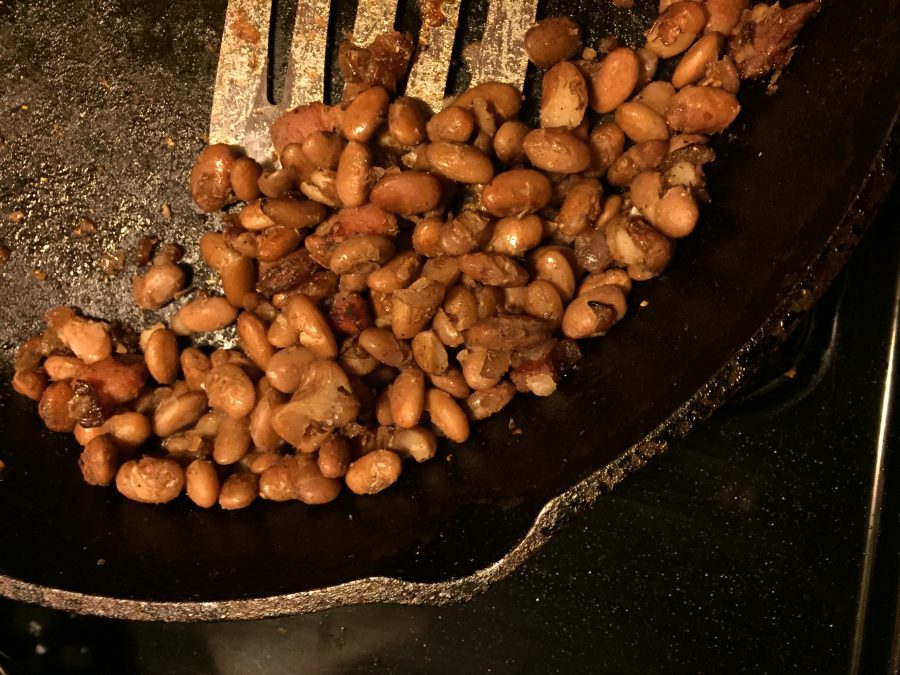
Beans
Plant protein! Beans are so much less expensive, healthier (sorry, Paleo peeps, the bulk of the science is on my side for this), and better for the planet than mea. Beans can serve as the main protein source for vegetarian folks, but since I really do love meat, I usually use beans to stretch out smaller meat portions in dishes. Combining different protein sources (vegetarian or not) creates more pleasing textures and flavors in your dish. And you can do some pretty cool things with beans, like puree them into dips or bake them into cookie and brownies!
Make your own or keep canned beans on hand and plan ahead so you make a couple different different dishes with them. I buy mine in the bulk section at the Concord Food Co-op (any popular natural food store with a good turnover should be as good), soak, and then cook in a pot of water til done or in my Instant Pot — theirs are fresher than at most grocery stores and take much less time to cook. Add salt to taste when they’re almost done cooking. You can freeze extras in smaller jars.
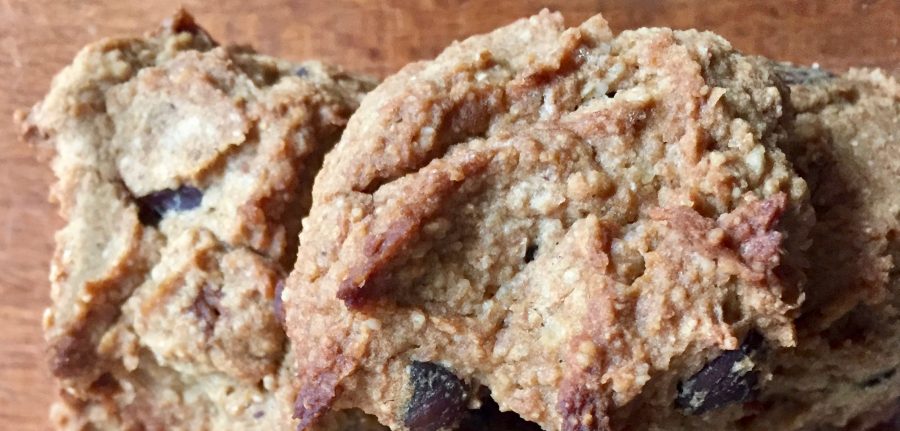
Chickpeas: Amazingly versatile, they have both a chicken-y and carb-y flavor that goes well with many different dishes. Toss them into curries and other Indian dishes, chicken soup (with or without the chicken), Italian and Middle Eastern cuisine (this Quick Tikka Masala recipe is amazing with chicken and/or chickpeas!), or make hummus. Excellent in soups, stews, bowls, salads, sautés. Need to use up a bunch all at once? Inspired by the recipe in Super Natural Every Day, you can mash them up with some lemon juice, olive oil, parsley, garlic to use as a chip dip or smear onto wraps as you would chicken salad or tuna. You can also roast them (about 400°F with olive oil, salt, pepper, crushed red pepper, turmeric, and rosemary — or your choice of flavorings — until crispy golden, serve immediately or let cool on the plan; this is delicious as a solo snack or as topper for a salad or bowl dish). Or you can make them into high-protein, gluten-free chickpea chocolate chip cookies (seriously!) or peanut butter chickpea cookies. You’ll be pretty amazed at all the things you can do with chickpeas — check the internet for recipes to make crackers and other high-fiber, high-protein (and often nut- and gluten-free) goodies.
Pintos: My second-favorite bean, these have such a nice texture and are my go-to in Mexican and New-Mexican-inspired dishes including tacos, chili, stews, and baked beans. Need to use up a bunch? They puree quite nicely (especially if you accidentally overcooked them) with salsa or simply olive oil, oregano, cumin, and crushed red pepper into a bean dip for chips and layered bean dips or to smear on wraps or sandwiches. Try my Quick Skillet “Baked” Beans Recipe: In a large cast-iron pan or skillet over medium heat, cook up a few pieces of bacon, remove, chop, and set aside. Pour out most of the bacon fat but leave about a teaspoon or two, then add another teaspoon or two of olive oil and sauté finely chopped onions until slightly golden. Add 2 cups of well-drained beans, sauté until golden. Add salt (if needed), black pepper, a 1/8 teaspoon of ground cardamom, 1/2 teaspoon ground coriander, let cook a minute or two more. Remove from heat, and add 1-2 tablespoons of maple syrup or brown sugar to taste, stir in the bacon bits. Serve with kale chips (I like mine with simply olive oil, salt, and crushed red pepper) for a complete, delicious, meat-light meal.
Black Beans: These can be used much like pinto beans in Latin-inspired fare where their smaller size and vivid color is preferred — tacos, tostadas, topping salads and salsas or roasted sweet potatoes, chili and other soups and stews, bowls (like this) and sautés. Need to use up a bunch? Besides making chili, you can bake them into pretty decent gluten-free brownies!
And of course you can also play around with lentils, white beans, and all sorts of other pulses, but the three above are my personal fave.
Greens
Raw or cooked, greens are the ultimate fast food vegetable and so versatile!
Prewashed Salad Greens: Whether you buy them in the plastic tubs or clean and chop up your own (which keep for a few days), these allow you to quickly throw together a salad as a main meal or quick side (because everything looks better on a bed of greens or next to a lovely side salad!). You can also pop them into tacos, bowls, with eggs, in wraps, under a burger/veggie burger/seafood cake… you get the idea! Lately I’ve been obsessed with the lef Farms greenhouse greens grown in Loudon — they’re so fresh and crispy! If you want to cook your green, opt for spinach, arugula, and baby kale.
Whole-Leaf Lettuce: Romaine, Boston bibb, and other large-leaf lettuce… Not only can you chop them into salad used as described above, but you can use them as cups and wraps galore! Stuff them with meat, beans, chopped veggies, grains, avocado, dressed with a yummy sauce. For example…
- Asian Style: Teriyaki-seasoned chicken/beef/shrimp/ground pork/tofu with some sticky or brown rice (or cauliflower rice), kimchi/fermented vegetables, basil or mint leaf, chopped scallions, sesame seeds, drizzle of teriyaki or other sweet-spicy Asian sauce
- Tex-Mex Style: Beans and/or taco-seasoned shrimp/pork/chicken/beef, chopped peppers/tomatoes/avocado/salsa, corn or rice, dollop of Greek yogurt or shredded cheese, chopped cilantro.
- You can easily increase/decrease the stuffing ingredients as desired! Match-sticked or thinly sliced veggies, fermented veggies, soft cheese, pureed beans or veggies, chopped fruit (such as mango or pineapple) also make nice ingredient options. Get more inspiration from this smörgåsbord of EatingWell lettuce wrap recipes. Also experiment with cabbage leaves, collard greens, chard (raw, blanched, or lightly cooked). These wraps always look gorgeous!
Kale Chips: One of my go-to easy greens. Curly green or red kale works best. It’s easy to strip from the stem very quickly (see this video). Simply rub with olive oil, liberal sprinkle of salt, light sprinkle of crushed red pepper (or whatever flavors you like), on a single layer, and bake at 290°F, tossing frequently, until crispy. If I’m baking other items, I’ll cook them alongside at the higher temp but I might remove the pan periodically so they don’t get burnt. Check and toss frequently — a few seconds could be the difference between crispy and burnt! I can eat an entire head of kale as a side or snack by myself, but if you have leftovers, you can throw them into dishes in the last seconds of cooking for a quick hit of green. They’re also fabulous with match-sticked roasted beets and and some goat cheese — a dish I usually share with Shannon but have managed to polish off solo (yes, an entire head of beets and kale — it’s that good!).
Shredded Cabbage: Using a sharp knife or mandoline (I wear a cut-resistant glove to prevent emergency room trips), thinly slice green and/or red cabbage into strips. This will keep in the fridge for about a week and can be used cooked or raw in a range of recipes including those tacos, bowls, sautés, fried rice, soup, under a fried egg, as a garnish and as a side slaw (whip up 1 clove of garlic with some fresh-squeezed lemon juice, olive oil, and optional drizzle of natural sweetener). Julienned carrots or radishes look lovely in this mix, too. Often I just store it raw and plain so I can add the dressing of my choice — such as this Asian dressing that I keep on hand for quick flavor for salads, meat, lettuce cups, bowls, and many other recipes.
Roasted Veggies
Roast a big pan of veggies to easily toss into dishes. You can cook them all the way to toss in and eat raw, or cook them until they’re nearly done so you can quickly finish browning a few here and there in the skillet for that fresh-baked flavor.
Sweet Potatoes, Winter Squash, or Other Root Veggies: A quick carb for hash browns alongside a fried egg, in a bowl dish, on salads, as an easy side for protein and vegetables.
Cauliflower: Cauliflower is ridiculously versatile. Alongside chickpeas, I think it’s one of those unsung heroes of healthy cooking and low-allergy swaps (unless, of course, you don’t do well with high-FODMAP foods… but if that’s the case, get your gut in gear so you can enjoy this amazing vegetable again!) It’s delicious simply roasted with some olive oil and salt until golden, then sprinkle with garlic powder and thyme (and perhaps a sprinkle of Parmesan) for a delicious side vegetable that can also be tossed into soups, bowls, sautés, etc. You can also toss your raw cauliflower into the food processor to pulse into low-carb, grain-free cauliflower “rice” (lightly cook in the skillet or pot — personally I prefer to cut cauliflower rice half and half with real rice since this tastes better and I’m not a big fan of hugely restrictive diets). With or without the real rice, cauliflower rice works very well in soups and stews, tucked next to curries and chili, in bowls, sautés, etc. Have leftover cauliflower? You can turn it into so many surprising things… cauliflower “steaks,” oven-baked buffalo bites (party food snack and taco ingredient — feel free to use white flour or gluten-free flour replacement), pizza crust, gnocchi…
Whole Grains & Basic Sautés
Cook up a couple cups of whole grain to easily add to soup, sauté in the skillet with other ingredients, fill a wrap, or serve alongside chili or curry. My personal favorites include brown rice (I do indulge sometimes in sticky white or Basmati rice), hearty Lundberg’s wild blend, millet, quinoa (partial to tri-color), or buckwheat, all of which I get from my local co-op’s bulk section and store in mason jars in the pantry. You can easily sub in the aforementioned cauliflower rice or a blend of grains with other ingredients already added in (such as millet/white bean/mushrooms/onions/garlic, or Chinese fried rice, or cauliflower/brown rice blend). Here’s a quick guide to cooking grains (I don’t bother soaking first). I usually add a tablespoon of butter (or olive/sesame/coconut oil) and a 1/2 teaspoon of salt to the pot. I prefer to cook grains in my Instant Pot (which comes with a cooking time guide) or rice cooker (which works for all sorts of grains, not just rice).
Broth & Miso
Yes, I’m one of those people who will drink plain salted homemade bone broth straight from a mug, especially when I’m teaching a long day (soothing for a dry throat) or feel like I’m coming down with something. But it’s also invaluable for soup recipes. You can use it to make big batches of soup, cook grains, or put together a quick bowl of soup so you can change it up throughout the week (maybe some of that pre-prepped chicken, thinly sliced prepped veggies or greens, cauliflower rice, grain, a dropped egg…). Chicken is my fave, prepared in the Instant Pot or on the stove (see previous chicken post), but you can play around with other meats or veggies. Store extras in freezer-safe pint mason jars or deli containers. In a pinch, a spoonful of miso works well too — I’m partial to Miso Master (barley and brown rice more classic, sweet white so nice with a little grated ginger and lemon juice), and you can even find gluten- and soy-free varieties such as chickpea miso. The miso tubs last pretty much forever in the back of your fridge. South River Miso’s also very popular.
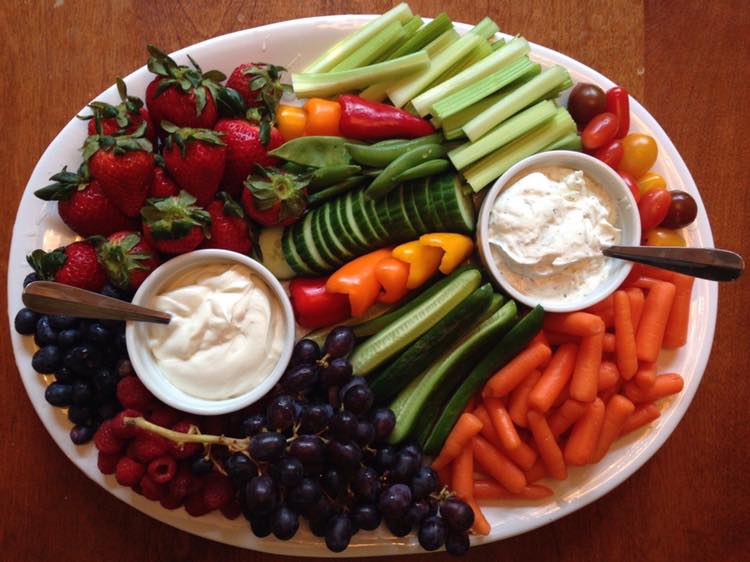
Prepped Veggies & Fruit
Besides the aforementioned greens, you can prep other veggies for an easy-toss into dishes or the pan or plunking into dip. Prepped carrots, sweet potatoes, celery, cabbage, cauliflower, and pineapple keep for about a week in the fridge. Zucchini and broccoli last a few days. Plan to prep bell peppers, onions, scallions, cucumbers, avocados, and most fruits as needed or for only a day or so’s worth at a time — they get mushy or develop off flavors pretty quickly.
Fermented Veggies, Toasted Seeds, Nuts, Dips & Dressings
It’s all about the condiments! Find the ones you love and keep them on hand, whether you buy them or make them from scratch.
Dressings & Yummy Sauces: I have dressing bottles at the ready with Asian dressing/marinade (this would be easy to do soy-free with coconut aminos and a smidge more salt BTW), my maple mustard fire cider dressing, store-bought Italian, and sriracha. I have this amazing spicy-sweet dressing I whipped up (combining approximately equal parts Stonewall Kitchen sriracha honey mustard dip with my maple fire cider dressing, toasted sesame oil, and regular sriracha… but I’m sure you could buy or whip up something similar more easily, perhaps some maple syrup + sriracha + sesame oil). It’s great on Thai-inspired lettuce wraps, Korean bibimbap, and the like. All these dressings keep in the fridge for months (years?), which suits my lifestyle nicely.
Fermented Veggies: The ultimate easy veggie to throw in with eggs, top a grain bowl, wrap, tacos, salad, or sauté! My personal stand-bys are Hawthorne Valley Original Sauerkraut and (when I want something a little spicy-Asian) Micro Mama’s Spicy Kimchi. But don’t stop there because so many cook fermented veggies are popping up in natural food store and farm store produce sections! Check out the book Fermented Vegetables for more on how to DIY so many different types of recipes.
Other Easy-Grab Items: Raw or roasted nuts, toasted seeds (being allergic to nuts, I buy raw hulled sesame and pumpkin/pepita seeds in the bulk section, toast in a dry skillet, and keep on hand), nut/seed butters, salsa, yogurt, fruit, veggie sticks, berries, plain yogurt, cheese, whole-grain crackers…. I make my own veggie Ranch dip mix to stir into Greek yogurt as needed (I’ve yet to find anything else natural that comes close to Hidden Valley ranch dip).

Frozen Soups
Last winter Shannon worked in Vermont for 3 months and decided to save money and be healthier by bringing a cooler full of frozen single-serving soups. I’ve always been reluctant to freeze meals because I like good food, and previously frozen food can be a lackluster shell of what it once was fresh. But, this lesson helped me find certain soup recipes that do freeze well. Now we keep a variety of soups and stews on hand for easy-grab lunches for him and occasionally for me. Favorites include meat-bean chili, split pea and ham soup, chicken soup with rice or root vegetables, Korean chicken soup (made with rice or zucchini noodles, dressed up with some fresh match-sticked veggies, scallions, and sesame seeds just before serving), butternut squash soup (no dairy, feel free to add chicken or sausage), and beef stew. Note that dairy and many veggies don’t freeze well, including broccoli, eggplant, and anything you prefer “al dente” — add them before serving if you like. But meat, beans, root veggies, rice (and most whole grains), and winter squash freeze and reheat nicely.
Freezer-safe wide-mouth pint mason jars work fabulously for this — just be mindful of the “fill line for freezing.” I’ve been pleasantly surprised how well they thaw in the microwave. Otherwise you’ll want to thaw them in the fridge. (Or on the counter, if you don’t mind a little food safety risk. Or in a bowl of warm water, if you don’t mind the risk of broken glass.) Plastic deli containers also work well (but, yes, plastic) — simply run under a bit of warm water to pop out your soup ice cube, then heat with a little water on the stove top. Other safety tips: Let soup cool (in the pot or big glass jars) before transferring to plastic containers. Let glass jars of soup cool before putting them in the freezer.
Now What? How to USE Those Easy-Grab Ingredients!
So, the idea is not to keep ALL of these things in the fridge but to select a rotation based on what kinds of meals you feel like eating. For example, I might keep rice, shredded zucchini, chicken, and cooked cauliflower on hand to reheat in a bowl dry, or cover with broth to have as a soup plain, or add some sriracha sauce/kimchi/sesame seeds/scallions for a Korean flare….
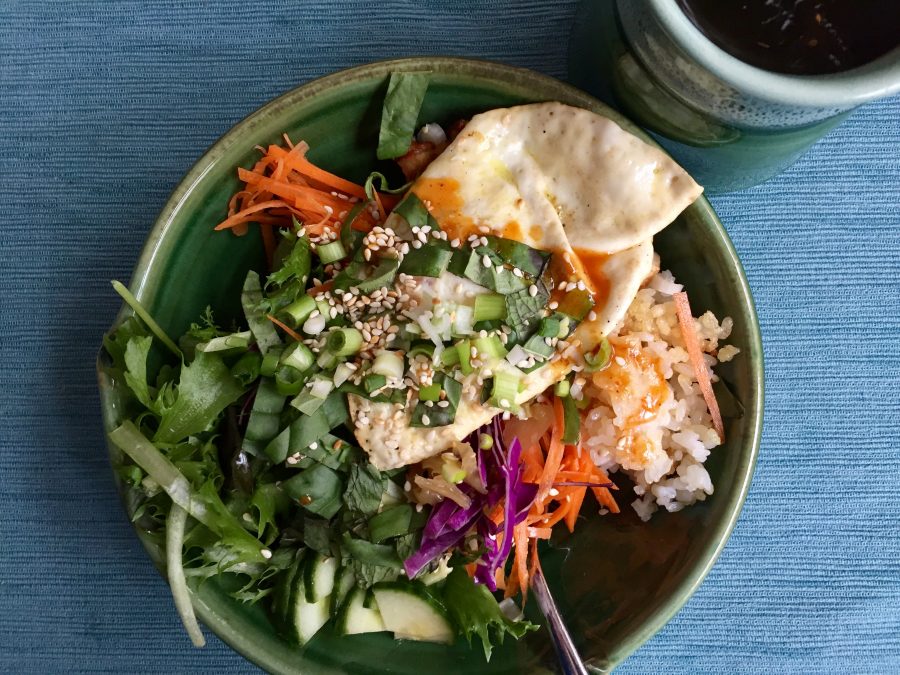
Bowls & Sautés: These are all the rage right now, sometimes called Buddah Bowls or grain bowls, and extremely versatile based on your tastes and what you have on hand. Basically: grain/cauliflower rice/noodles/roasted sweet potatoes + match sticked or diced colorful veggies and/or greens + meat/shrimp/beans/toasted nuts/egg + yummy sauce + finely chopped herbs. Think of a rainbow of colors and a blend of protein + complex carbs + veggies + tasty ingredients. Pinch of Yum has a ton of gorgeous, delicious recipes to inspire you, as does EatingWell. Tip: sesame seeds, scallions, and a sprinkle of something colorful (red cabbage, match sticked carrots, thinly sliced radish, diced peppers, avocado slices) adds the wow factor.
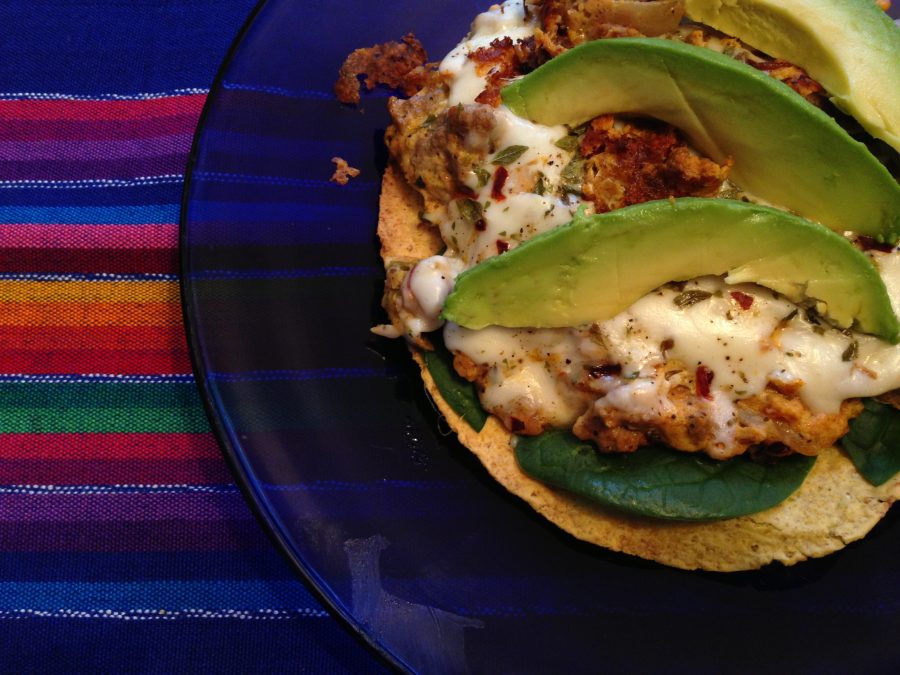
Tacos & Tostadas: Also so versatile! Classic with a flour or corn tortilla (I’m partial to toasted Food for Life organic sprouted corn tortillas) but you can also find recipes for chia and other gluten-free or grain-free recipes if you’d like. Most taco shells taste best freshly made, otherwise toasted, or warmed/charred over the gas burner. Meat/seafood/beans + thinly sliced or diced raw or lightly cooked veggies (sweet potato, onions, peppers, mushrooms, carrots, cabbage…). Add flavor and texture with fermented veggies, slaw, greens, a dollop of plain yogurt, salsa, cheese, scallions, cilantro, and/or avocado.
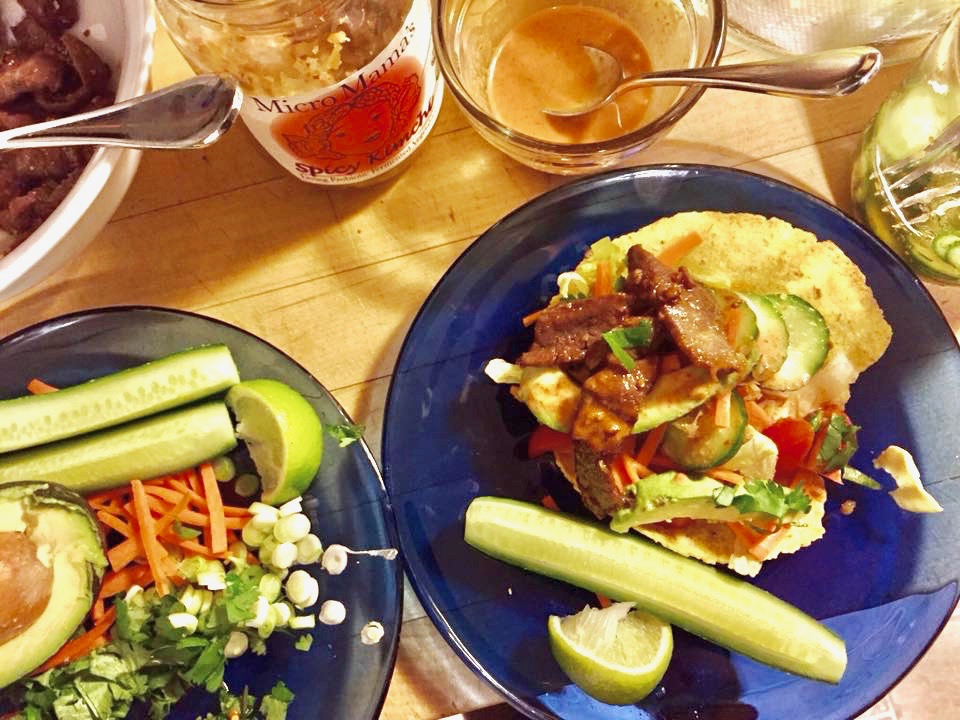
Salads & Lettuce Wraps: Check out the aforementioned lettuce wrap recipe ideas in the “Greens” section above. Sometimes all you need to do is serve some food atop of a bed of greens (what could be easier?) or make a super simple side salad (to go with a nice cup of soup, eggs, or grilled protein + roasted carb, perhaps?) like…
- lettuce + sliced cukes + Italian dressing
- mixed greens + sliced pineapple + Asian dressing (see “Dressings” above) + sesame seeds
- mixed greens + toasted pepita seeds + dried cranberries or sliced apple + maple mustard fire cider dressing (see recipe in “Dressings”)
- mixed greens + sliced roasted or pickled beets + fennel-infused vinegar & olive oil or the maple mustard fire cider dressing + goat cheese
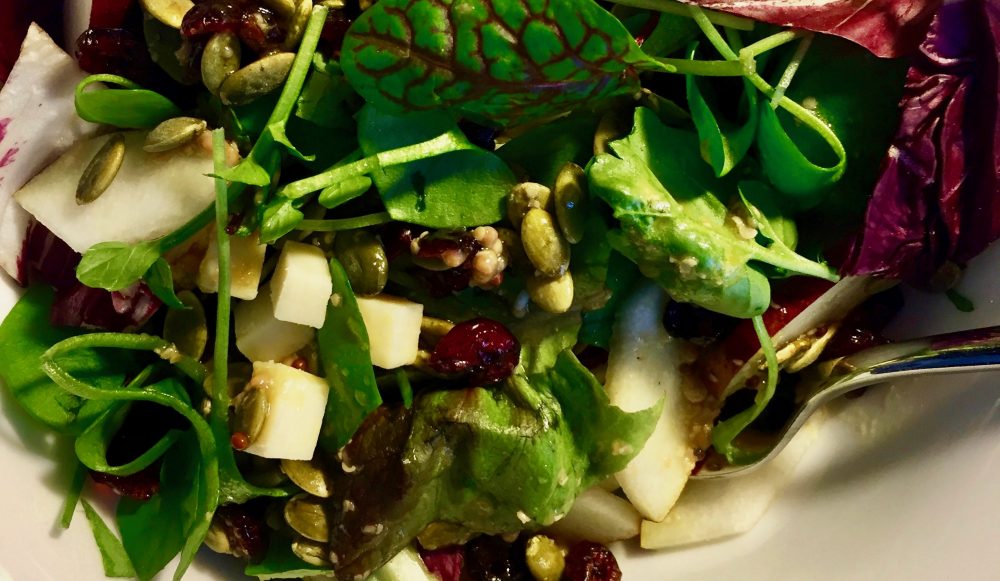
Or you can make it a meal in a big bowl by adding protein and a complex carb and some good fat from avocados or olives. Such as…
- Mexican: lettuce + beans + chicken + avocado + peppers + roasted sweet potatoes dressed with lime juice, olive oil, salt, pepper, and cilantro
- Italian: lettuce + chickpeas + chicken + Italian dressing
- Mediterranean: lettuce + sardines + cucumber + tomato + avocado + Italian dressing
- Asian: lettuce + shrimp + match sticked carrots/radish + Asian dressing or yum yum sauce
Make It Beautiful
Besides going for a rainbow of colors (as mentioned above), indulge yourself in something beautiful such as a nice rectangular plate to lay out multiple items, or some pretty pottery. Light some candles, change up your place mats and cloth napkins, or put flowers on the table. Drink out of a fancy cocktail or wine glass (even if it’s “just” seltzer), perhaps with a garnish or sexy big ice cube. It doesn’t need to be a special occasion, and you don’t need company to treat yourself to a beautifully laid out meal!
Buon appetito!
Clinical herbalist Maria Noël Groves sees clients and teaches classes at Wintergreen Botanicals Herbal Clinic & Education Center in Allenstown, New Hampshire.
Full disclosure: The Amazon links are affiliate links (so if you buy them, I make a few pennies at no extra cost to you), but I’ve included them because I actually like and own those products. 🙂

